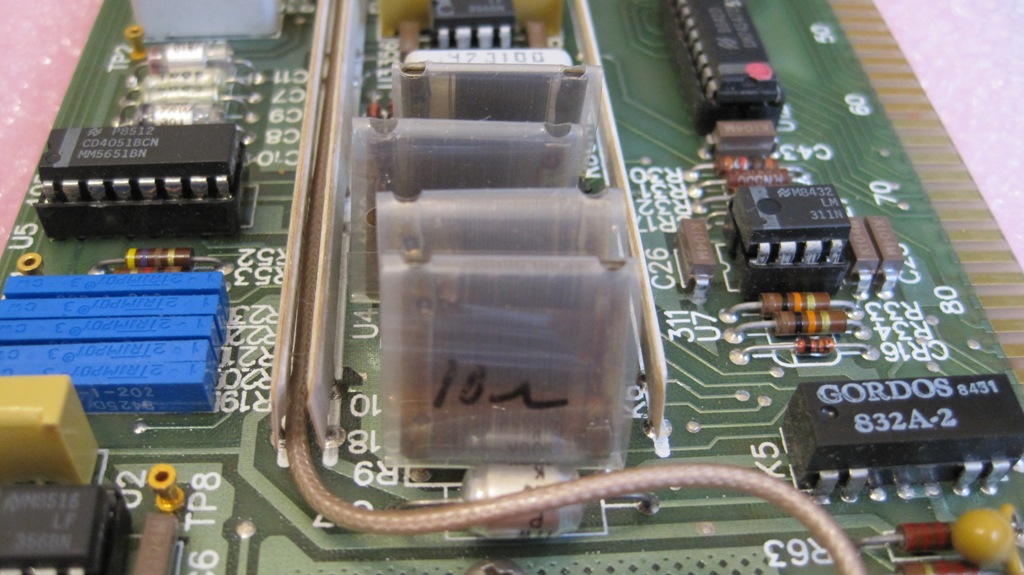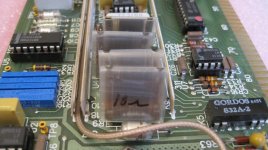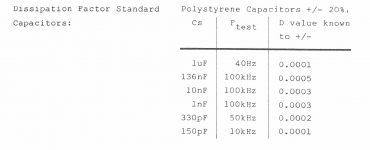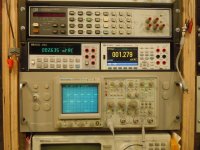There is always something more to get. . . I have 3 ESI Videobridges but for small caps and in circuit measurements I have a Tek 130 and for large (100,000 uF) a speciazed HP meter. And a GR digibridge. And I use the Videobridge some, the others once a year. It's too easy to overdo the measurement thing. What is important is knowing what to look for and how those boxes can lie.
Hi Demian,
You're so right. It's easy to allow equipment to "lie" to you.
What's an ESI Videobridge? What characteristics does it have that attracted you to them. Given that you have three, they must be important to have running.
I use my 4263A quite a bit. Usually every few days on average. It's also used to measure shielded cable, not just capacitors.
You're so right. It's easy to allow equipment to "lie" to you.
What's an ESI Videobridge? What characteristics does it have that attracted you to them. Given that you have three, they must be important to have running.
I use my 4263A quite a bit. Usually every few days on average. It's also used to measure shielded cable, not just capacitors.
ESI was a major source of lab reference standards for resistors and they also made some instruments. The Videobridge is older (uses an S100 buss inside) with a full 8080 computer to run it and drive a video display. First gen (I have 2) 2Hz to 20 KHz impedance with .02% accuracy and 6 digits. Later gen (I have 1) goes to 150 KHz and has better software. ESI 2160 Video Bridge (Auto LCR Meter) I have 3 because they were there and cheap and I did not want to worry about fixing one. So now I have two that need repair. . .
For higher frequencies a vector network analyzer is probably a better choice. It has more uses as well.
For higher frequencies a vector network analyzer is probably a better choice. It has more uses as well.
I don't know....looks more like a fun bench to me!here
Hi Demian,
So, the 2160 would be the one to get I guess. I do have an HP 4195A with the impedance measurement kit. I just have to find some APC-7 connectors to make my own stages. Those connectors aren't cheap either.
How would you rate the Genrad products? As far as I can see, the biggest difference would be the switching between scales to get all the parameters with. I have never had either, just the HP models. So, if I'm going to get one, I would like to get the one that is the best for using it. I'm not doing incoming inspections all the time (but I do measure a couple from each lot I receive). These days I only really trust what I can measure on my own. That's not Ebay parts, but parts I get from the proper distribution chain.
I see the Tektronix 130 is an old meter type instrument. Interesting. You would think that someone would have come out with a better digital equivalent by now.
Best, Chris
So, the 2160 would be the one to get I guess. I do have an HP 4195A with the impedance measurement kit. I just have to find some APC-7 connectors to make my own stages. Those connectors aren't cheap either.
How would you rate the Genrad products? As far as I can see, the biggest difference would be the switching between scales to get all the parameters with. I have never had either, just the HP models. So, if I'm going to get one, I would like to get the one that is the best for using it. I'm not doing incoming inspections all the time (but I do measure a couple from each lot I receive). These days I only really trust what I can measure on my own. That's not Ebay parts, but parts I get from the proper distribution chain.
I see the Tektronix 130 is an old meter type instrument. Interesting. You would think that someone would have come out with a better digital equivalent by now.
Best, Chris
Better get the 2150 same spec as the 2160 without the cassette. The GenRad 1689/1689M/1693 has the same basic 0.02% basic accuracy.
The ESI 2100/2110 were originally quoted with 0.02% basic accuracy but was later downgraded to 0.05%. These ESIs use 50ppm foil resistors as part of their internal standard.
The ESI 2100/2110 were originally quoted with 0.02% basic accuracy but was later downgraded to 0.05%. These ESIs use 50ppm foil resistors as part of their internal standard.
Hi Demian,
Thank you very much for clarifying the differences. I was already talking to someone about the ESI testers with the screen. Certainly do not need the cassette drive!
If they are too expensive I can go with the Genrad product, but I'm assuming the video display merely makes gets in the figures more convenient.
-Chris
Thank you very much for clarifying the differences. I was already talking to someone about the ESI testers with the screen. Certainly do not need the cassette drive!
If they are too expensive I can go with the Genrad product, but I'm assuming the video display merely makes gets in the figures more convenient.
-Chris
Better get the 2150 same spec as the 2160 without the cassette. The GenRad 1689/1689M/1693 has the same basic 0.02% basic accuracy.
The ESI 2100/2110 were originally quoted with 0.02% basic accuracy but was later downgraded to 0.05%. These ESIs use 50ppm foil resistors as part of their internal standard.
The ones I have all have the ESI wirewound SR-1 style resistors, 7 of them I think. Much closer tolerance and tighter TC. Still the .02% seems pretty optimistic.
Here are the 4x 50 ppm resistor standards on my 2150. I initially thought they were foils but upon closer inspection, they are actually wirewound. Duhh. In fairness, the last time I looked at them, I did not use any magnifying glass 
ESI 2150/2160 quoted 0.02% accuracy is for specific value range, measurement speed, frequency, test voltage, fully shielded connections, temperature, etc.
Capacitance from 1nF to 10uF at 1kHz is 0.02%
Inductance from around 1mH to 20H at 1kHz is 0.05% aha!
Resistance between 10Ohms and 100kOhms at 1kHz is 0.02%
I'm not a metrology lab with a controlled environment, etc. I try not to get carried away with its quoted 0.02% accuracy knowing its limits. As they say on most electronics laboratory, "For Indication Only".
It's a wonderful machine if it is working. I rebuilt mine almost 10 years ago and used it regularly together with the ESI 2005 Kelvin tweezers for all sorts of odd jobs. It's a keeper.

ESI 2150/2160 quoted 0.02% accuracy is for specific value range, measurement speed, frequency, test voltage, fully shielded connections, temperature, etc.
Capacitance from 1nF to 10uF at 1kHz is 0.02%
Inductance from around 1mH to 20H at 1kHz is 0.05% aha!
Resistance between 10Ohms and 100kOhms at 1kHz is 0.02%
I'm not a metrology lab with a controlled environment, etc. I try not to get carried away with its quoted 0.02% accuracy knowing its limits. As they say on most electronics laboratory, "For Indication Only".
It's a wonderful machine if it is working. I rebuilt mine almost 10 years ago and used it regularly together with the ESI 2005 Kelvin tweezers for all sorts of odd jobs. It's a keeper.
Attachments
I have seen nothing to replace it and most new instruments with similar capabilities are way more expensive.
The fan is noisy but that ensures I don't leave it on.
If necessary you could replace a defective resistor with a Vishay S102 but that is really unlikely to ever be needed.
I'm not sure how to verify the calibration anyway except with some resistors at lower frequencies. When I have it seems to be on cal. The tough part of the cal is a very low d cap at the target values in the cal process. How can you be sure of .001%D on a cap?
The fan is noisy but that ensures I don't leave it on.
If necessary you could replace a defective resistor with a Vishay S102 but that is really unlikely to ever be needed.
I'm not sure how to verify the calibration anyway except with some resistors at lower frequencies. When I have it seems to be on cal. The tough part of the cal is a very low d cap at the target values in the cal process. How can you be sure of .001%D on a cap?
I just got my Tektronix 2465B back today thanks to Kay (kct) who did a wonderful job of replacing capacitors and saving the NVRAM to a new chip. He also left that information on a USB stick that I taped to the top of the unit. I believe there was also some electrolyte to clean up. Leaking capacitors.
So here it is!
-Chris
So here it is!
-Chris
Attachments
Hi Suzy,
Thanks!!
I'm just really happy to have it back and functioning. The rack mount was a gift from kct (Kay) who repaired it for me.
I didn't know that all the portable Tek scopes could share hardware like handles and such. Another thing to keep in mind.
I'm keeping the previous scope as a backup, a Philips PM3365. It has an excellent trace, but when you are running this scope, you are not doing FM alignments. That's a trait it shares with the PM3070 (which I bought new 27 years ago). I have rebuilt the PM3070 and its still going, so a pretty good scope.
I still have an HP 1722A and a Tek 465 to rebuild for my collection. The HP is a 275 MHz, dual trace built in the early 1970's! That's pretty amazing! I would hate to see how much it cost back then. It was running briefly and was a really nice scope to use. Other capacitors (I think) are cutting that party short.
-Chris
Thanks!!
I'm just really happy to have it back and functioning. The rack mount was a gift from kct (Kay) who repaired it for me.
I didn't know that all the portable Tek scopes could share hardware like handles and such. Another thing to keep in mind.
I'm keeping the previous scope as a backup, a Philips PM3365. It has an excellent trace, but when you are running this scope, you are not doing FM alignments. That's a trait it shares with the PM3070 (which I bought new 27 years ago). I have rebuilt the PM3070 and its still going, so a pretty good scope.
I still have an HP 1722A and a Tek 465 to rebuild for my collection. The HP is a 275 MHz, dual trace built in the early 1970's! That's pretty amazing! I would hate to see how much it cost back then. It was running briefly and was a really nice scope to use. Other capacitors (I think) are cutting that party short.
-Chris
I'm keeping the previous scope as a backup, a Philips PM3365. It has an excellent trace, but when you are running this scope, you are not doing FM alignments. That's a trait it shares with the PM3070 (which I bought new 27 years ago). I have rebuilt the PM3070 and its still going, so a pretty good scope.
Chris -- what probes are you using for FM alignments. I only have the P6137 for my 2465BCT
Jack
Hi Jack,
I use a mix of HP 500 MHz probes, the original Philips probes that it came with and when the work isn't demanding, those cheap Ebay probes. It doesn't hurt when something happens to those. All the probes are 10:1, the Ebay probes are all glued (epoxy) to the 10:1 position.
-Chris
I use a mix of HP 500 MHz probes, the original Philips probes that it came with and when the work isn't demanding, those cheap Ebay probes. It doesn't hurt when something happens to those. All the probes are 10:1, the Ebay probes are all glued (epoxy) to the 10:1 position.
-Chris
Hi Jack,
Why do you need a scope probe for an FM alignment?
I can not recall ever needing one except to troubleshoot. for trouble shooting RF it is best to have a active fet probe as to not load down the circuits as a passive probe would.
I guess it depends on the model and the procedure they wrote up if it applies. Many times the procedures were written for what they had as equipment, which was limited at those times what a tech or service shop could afford.
Sansui liked their genescope? I have never seen one myself.
Why do you need a scope probe for an FM alignment?
I can not recall ever needing one except to troubleshoot. for trouble shooting RF it is best to have a active fet probe as to not load down the circuits as a passive probe would.
I guess it depends on the model and the procedure they wrote up if it applies. Many times the procedures were written for what they had as equipment, which was limited at those times what a tech or service shop could afford.
Sansui liked their genescope? I have never seen one myself.
- Home
- Design & Build
- Equipment & Tools
- What's on your workbench???


